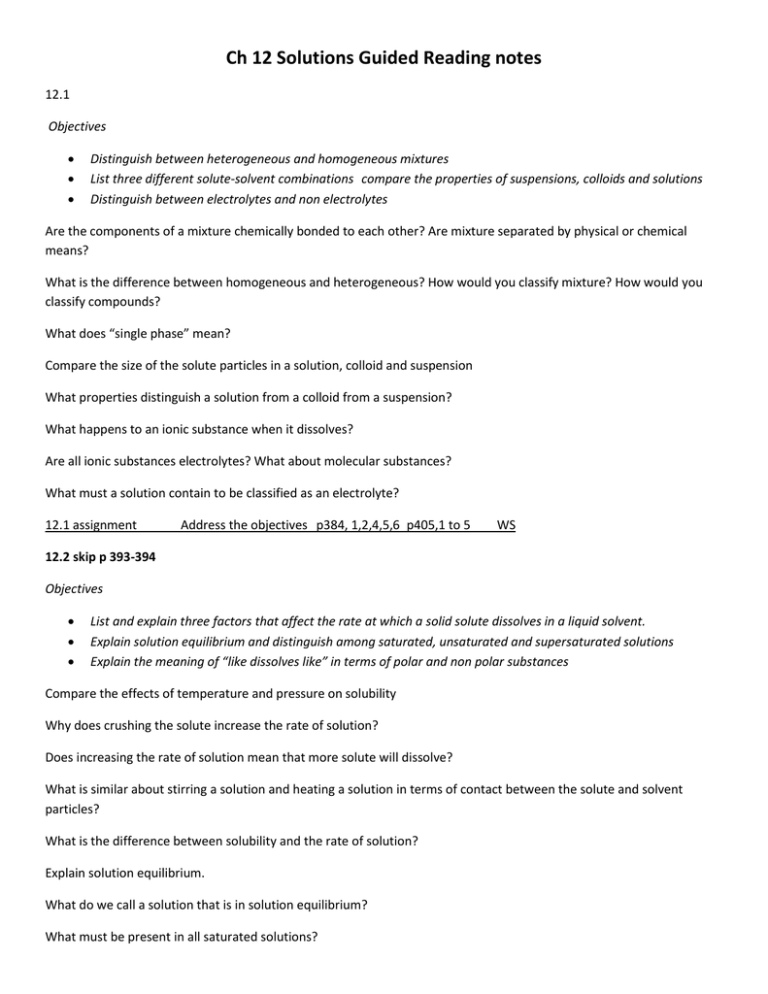File chem ch 12 solutions guided reading notes
advertisement

Ch 12 Solutions Guided Reading notes 12.1 Objectives Distinguish between heterogeneous and homogeneous mixtures List three different solute-solvent combinations compare the properties of suspensions, colloids and solutions Distinguish between electrolytes and non electrolytes Are the components of a mixture chemically bonded to each other? Are mixture separated by physical or chemical means? What is the difference between homogeneous and heterogeneous? How would you classify mixture? How would you classify compounds? What does “single phase” mean? Compare the size of the solute particles in a solution, colloid and suspension What properties distinguish a solution from a colloid from a suspension? What happens to an ionic substance when it dissolves? Are all ionic substances electrolytes? What about molecular substances? What must a solution contain to be classified as an electrolyte? 12.1 assignment Address the objectives p384, 1,2,4,5,6 p405,1 to 5 WS 12.2 skip p 393-394 Objectives List and explain three factors that affect the rate at which a solid solute dissolves in a liquid solvent. Explain solution equilibrium and distinguish among saturated, unsaturated and supersaturated solutions Explain the meaning of “like dissolves like” in terms of polar and non polar substances Compare the effects of temperature and pressure on solubility Why does crushing the solute increase the rate of solution? Does increasing the rate of solution mean that more solute will dissolve? What is similar about stirring a solution and heating a solution in terms of contact between the solute and solvent particles? What is the difference between solubility and the rate of solution? Explain solution equilibrium. What do we call a solution that is in solution equilibrium? What must be present in all saturated solutions? Explain how to make a supersaturated solution. Why are solubility values given for specific temperatures? What does “like” refer to in “like dissolves like”? In a solution of table salt and water, are there any formula units of NaCl present? Explain Why are ionic compounds soluble in water? Why does oil rise to the top of an oil/water mixture? Why are nonpolar substances soluble in nonpolar solvents? How does an increase in pressure in a gas/liquid solution cause the equilibrium to shift? What is the effect of temperature on the solubility of most gases? Of most solids? What is the effect of pressure on the solubility of most gases? On the solubility of most solids? 12.2 assignment address the objectives p 394, 1 to 7, skip 4 p405, 6 to 14, skip 13a,b,c WS 12.3 Objectives Given the mass of a solute and the volume of a solvent, calculate the concentration of a solution Given the concentration of a solution, determine the amount of solute in a given amount of solution Given the concentration of a solution, determine the amount of solution that contains a given amount of solute Do the terms concentrated and dilute refer to the solubility of a solute? Explain Describe the preparation of 500ml of a 0.5 molar solution of NaCl. Which is more concentrated, a 0.75M solution or a 2.5M solution? Which is more concentrated 10ml of a 0.5M solution or 100mL of a 0.5M solution? Do practice probs p 399 , 1,2,3 CP ends here, Adv keep going What is the difference between Molarity and Molality? NOTE Molarity talks about volume of SOLUTION, Molality talks about mass of SOLVENT The density of water is 1g per 1mL. What is the mass of 100mL of water? What is the mass in grams of 1000Ml of water? What is the mass in kilograms of 1 liter of water? Do practice probs 1,2 p 402 12.3 assignment address the objectives p 402, adv 1 to 4, cp 1 to 3 problems dealing with MOLALITY, adv do all 15 to 30 ws Ch 12 review assignment p 406 31 to 38, p 409 1 to 11 WS p405-406 CP, skip any questions or






